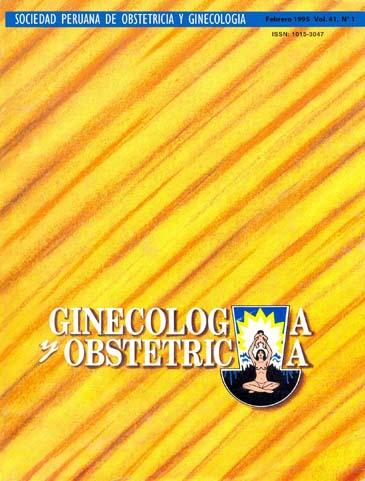Perfil biofísico ecográfico (PBE) en vigilancia fetal.
DOI:
https://doi.org/10.31403/rpgo.v41i1706Resumen
Se informa los resultados de un estudio longitudinal prospectivo realizado entre 1988y 1993, con el objetivo de determinar el valor predictivo, en el estado de la salud fetal, del perfil biofísico ecográfico (PBE) ideado por el primer autor, el cual utiliza siete parámetros fetoplacentarios evaluados por ultra-sonografía: movimientos corporales, movimientos respiratorios, tono fetal, frecuencia cardiaca basal, reactividad cardiaca, volumen de líquido amniótico y madurez placentaria. A cada parámetro normal se le asignó dos puntos. Se efectuó l434 estudios en gestantes de riesgo alto con más de 27 semanas de gestación que tenían presunción diagnóstica de: embarazo prolongado, hipertensión inducida por el embarazo, sufrimiento fetal, retardo de crecimiento intratuterino, rotura prematura de membranas y otros. Se consideró como PBE normal un puntaje de 11 a 14, relacionándose los puntajes a uno o más de los siguientes resultados perinatales adversos: oligohidramnios clínico, líquido meconial espeso, Apgar menor de 8 a los 5 minutos, convulsiones neonatales, muerte perinatal. Los valores del PBE fueron: sensibilidad 82,6%, especificidad 98,8%, valor predictivo positivo 88,801ó, valor predictivo, negativo 98,1%, índice de falsos positivos 11,2%, índice de falsos negativos 1,9%, la prevalencia fue 10%. La tasa de cesáreas en el grupo de estudio fue menor a la global hospitalaria y la mortalidad perinatal 0, ó9 x 1000 n. v., mucho menor a la global. Estos resultados ubican al PBE entre las pruebas de mayor valor en vigilancia fetal.Descargas
Descargas
Publicado
2015-07-31
Cómo citar
Huamán, M., Pacheco, J., Rosales, H., & Arias, L. (2015). Perfil biofísico ecográfico (PBE) en vigilancia fetal. Revista Peruana De Ginecología Y Obstetricia, 41(1), 52–55. https://doi.org/10.31403/rpgo.v41i1706
Número
Sección
Artículos Originales
















